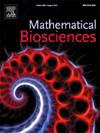Testing-isolation interventions will likely be insufficient to contain future novel disease outbreaks
IF 1.8
4区 数学
Q2 BIOLOGY
引用次数: 0
Abstract
Rapid identification and isolation of infected individuals with diagnostic testing plays a critical role in combating invasions of novel human pathogens. Unfortunately, unprepared health agencies may struggle to meet the massive testing capacity demands imposed by an outbreaking novel pathogen, potentially resulting in a failure of epidemic containment as occurred with COVID-19. Despite the critical importance of understanding the likelihood of such an outcome, it remains unclear how the particular characteristics of a novel disease will impact the magnitude of resource constraints on controllability. Specifically, is the failure of testing-isolation unique to COVID-19, or is this a likely outcome across the spectrum of disease traits that may constitute future epidemics? Here, using a generalized mathematical model parameterized for seven different human diseases and variants, we show that testing-isolation strategies will typically fail to contain epidemic outbreaks at practicably achievable testing capacities. From this analysis, we identify three key disease characteristics that govern controllability under resource constraints; the basic reproduction number, mean latent period, and non-symptomatic transmission index. Interactions among these characteristics play prominent roles in both explaining controllability differences among diseases and enhancing the efficacy of testing-isolation in combination with transmission-reduction measures. This study provides broad guidelines for managing controllability expectations during future novel disease invasions, describing which classes of diseases are most amenable to testing-isolation strategies alone and which will necessitate additional transmission-reduction measures like social distancing.
检测隔离干预措施很可能不足以遏制未来新型疾病的爆发。
通过诊断检测快速识别和隔离受感染个体在对抗新型人类病原体入侵方面发挥着关键作用。不幸的是,毫无准备的卫生机构可能难以满足爆发的新型病原体所带来的大量检测能力需求,这可能导致像COVID-19那样的流行病控制失败。尽管了解这种结果的可能性至关重要,但尚不清楚一种新疾病的特定特征将如何影响可控性资源限制的程度。具体来说,检测隔离失败是COVID-19独有的,还是这是可能构成未来流行病的各种疾病特征的可能结果?在这里,我们使用一个广义的数学模型参数化了七种不同的人类疾病和变异,我们表明测试隔离策略通常无法在实际可实现的测试能力下控制流行病的爆发。从这一分析中,我们确定了在资源限制下控制可控性的三个关键疾病特征;基本繁殖数、平均潜伏期、无症状传播指数。这些特征之间的相互作用在解释疾病之间可控性差异和增强检测隔离与减少传播措施相结合的效果方面发挥着突出作用。这项研究为未来新疾病入侵期间管理可控性预期提供了广泛的指导方针,描述了哪些类别的疾病最适合单独采用检测隔离策略,哪些将需要额外的减少传播措施,如社会距离。
本文章由计算机程序翻译,如有差异,请以英文原文为准。
求助全文
约1分钟内获得全文
求助全文
来源期刊

Mathematical Biosciences
生物-生物学
CiteScore
7.50
自引率
2.30%
发文量
67
审稿时长
18 days
期刊介绍:
Mathematical Biosciences publishes work providing new concepts or new understanding of biological systems using mathematical models, or methodological articles likely to find application to multiple biological systems. Papers are expected to present a major research finding of broad significance for the biological sciences, or mathematical biology. Mathematical Biosciences welcomes original research articles, letters, reviews and perspectives.
 求助内容:
求助内容: 应助结果提醒方式:
应助结果提醒方式:


